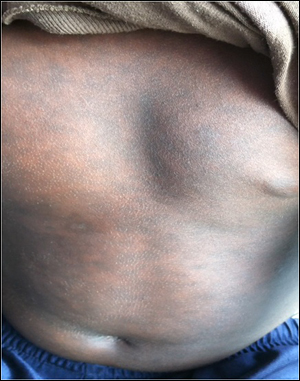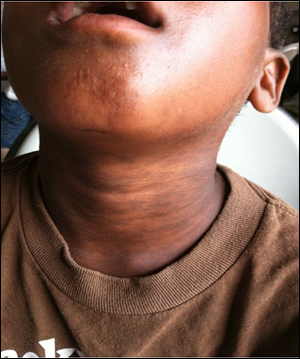A 10-year-old with rash on trunk and anterior neck
Click Here to Manage Email Alerts
A 10-year-old boy presents to your clinic with a rash on his trunk and anterior neck. His mother stated he had this rash since he was aged 2 to 3 years. The patient has never seen a doctor and was asymptomatic to date. Systemic examination was benign and the patient had no joint swelling, fever or abdominal pain.
On physical examination, there are multiple ash-colored, partially confluent, macular lesions found over the patient's trunk, but no other complaints. Basic tests such as mycologic cultures, erythrocyte sedimentation rate, glucose studies, liver function and urinalysis were all within normal limits. The Venereal Disease Research Laboratory Test was also negative.


What is your diagnosis?
Diagnosis: Erythema Dyschromicum Perstans (EDP)
EDP, also called ashy dermatosis, is a chronic cutaneous pigmentation disorder that is most common in Hispanic patients. EDP is found mostly in Latin America and Asia with the majority of cases occurring in El Salvador. This disorder seems to affect darker-skinned individuals more often than lighter-skinned individuals. The etiology of EDP is unknown but has been associated with an ingestion of ammonium nitrate and whipworm infestations.
Patients with EDP are asymptomatic with the exception of the rash. No fever, joint swelling or pain is noted. EDP are oval, polycyclic, or irregularly shaped, gray-blue hyperpigmented macules. These lesions are mostly found on the trunk, arms, face and neck; however, they can also be found on other parts of the body. These macules do not appear on the scalp, mucous membranes, palms or soles. The rash begins as ash-colored macules with variable shapes and sized with an erythematous or elevated border.
The etiology of EDP is unknown however, it has been associated with an ingestion of ammonium nitrate and whipworm infestations.
Basic tests such a mycologic cultures, erythocyte sedimentation rate, glucose studies, liver function, and urinalysis present within normal limits. The Venereal Disease Research Laboratory Test would also be negative.
There are no definitive treatment for EDP, however, clofazimine administered either 1 mg every other day to patients weighing less than 40 kg or 100 mg every day to patients weighing more than 40 kg has shown promise. Clofazimine should be continued for 3 months, then reduced to 200 mg/week and 400 mg/week, respecitively. EDP may persist for years although some cases have resolved by themselves.
– Written/contributed by Joseph P. Peter, MD, Alexander Philip and David Alaniz, RN, BSN
For more information:
-
Schwartz R. EMedicine.Medscape. emedicine.medscape.com/article/1122807-clinical
Disclosure: The researchers report no relevant financial disclosures.
